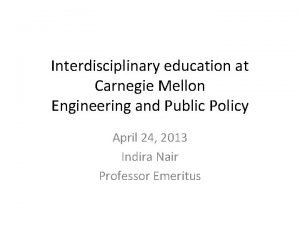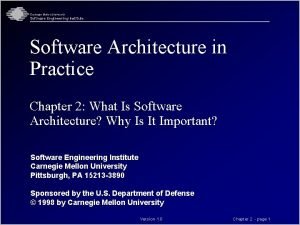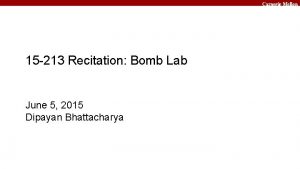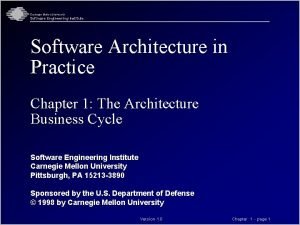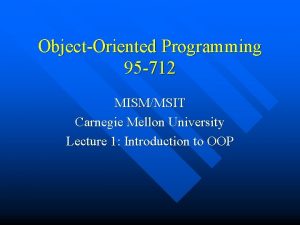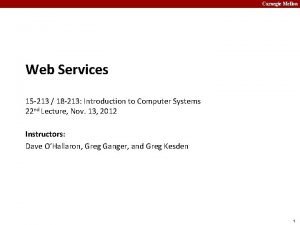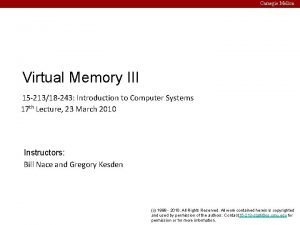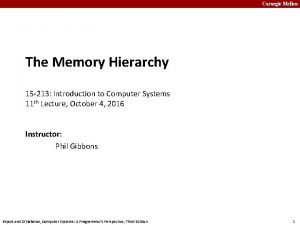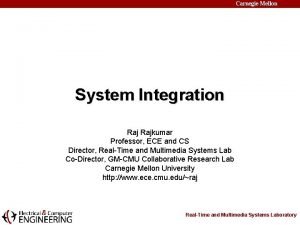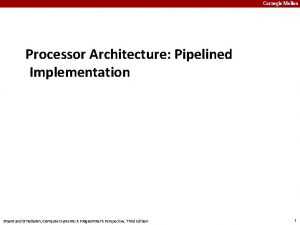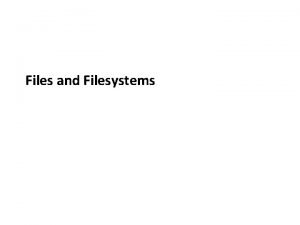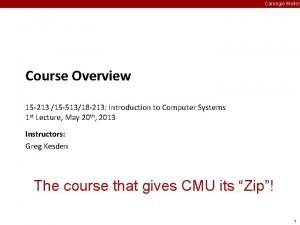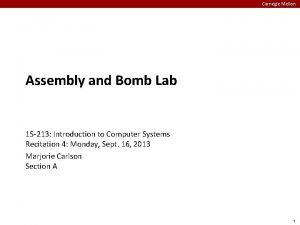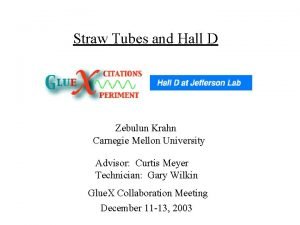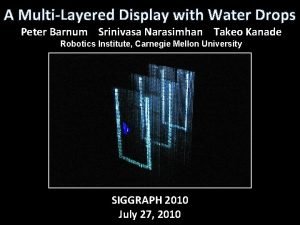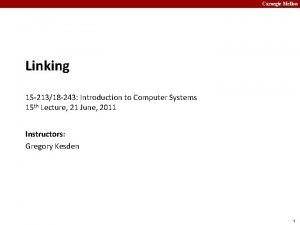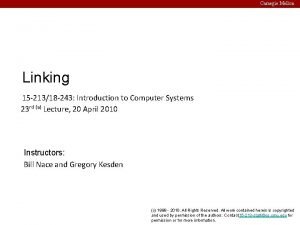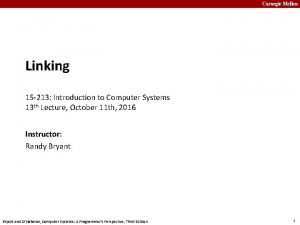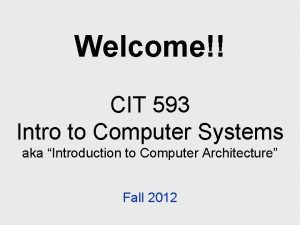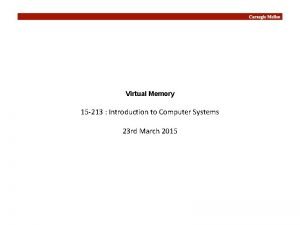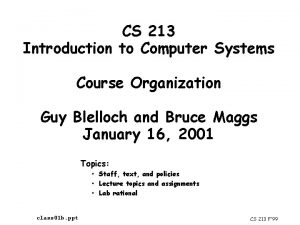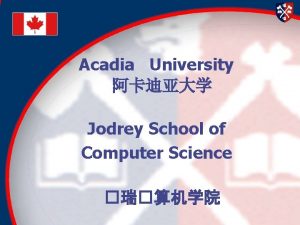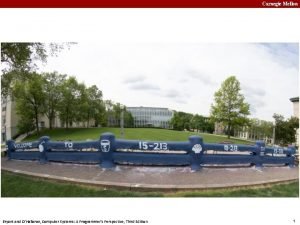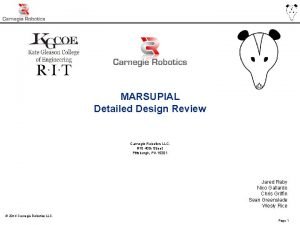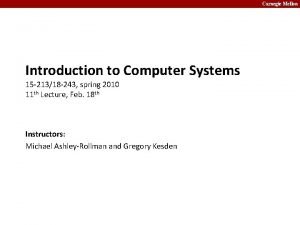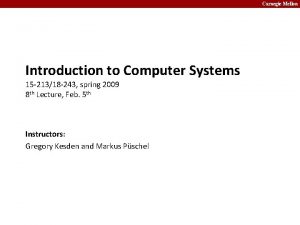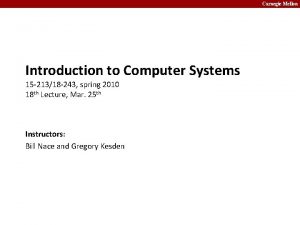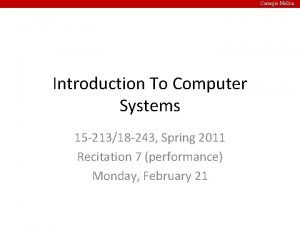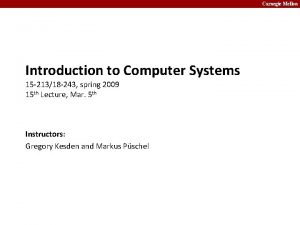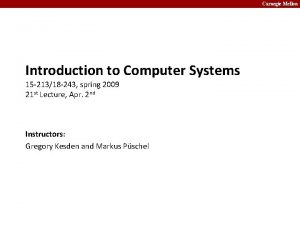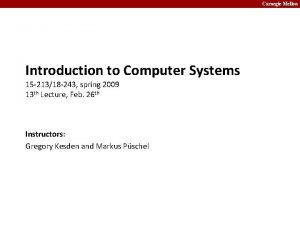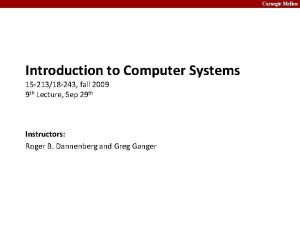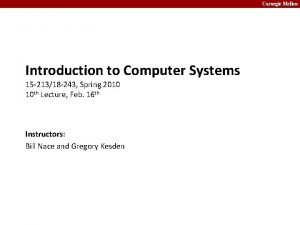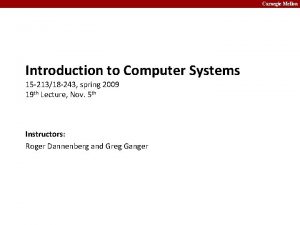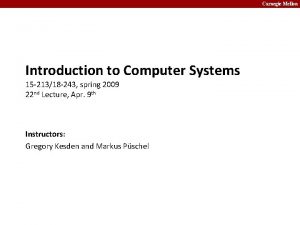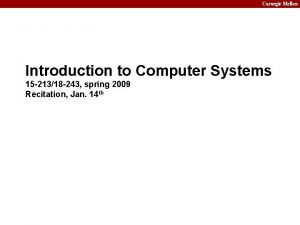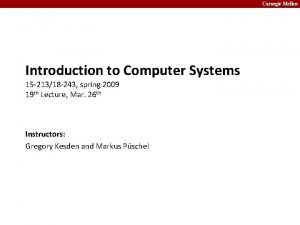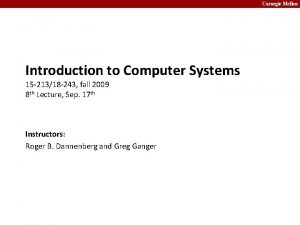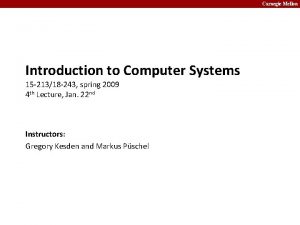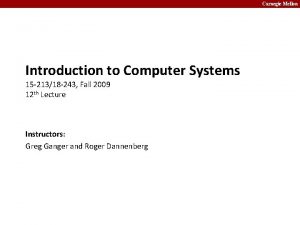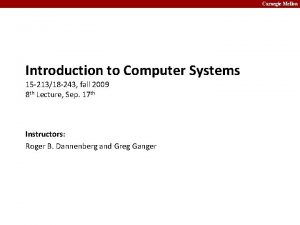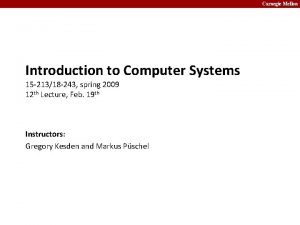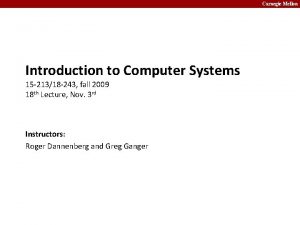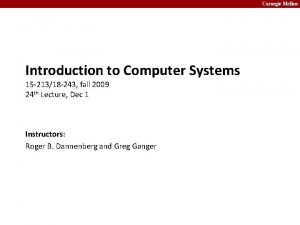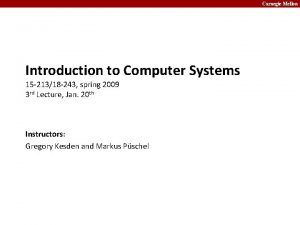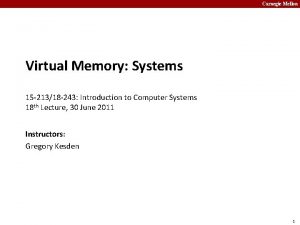Carnegie Mellon Introduction to Computer Systems 15 21318
















































- Slides: 48

Carnegie Mellon Introduction to Computer Systems 15 -213/18 -243, spring 2009 18 th Lecture, Mar. 24 th Instructors: Gregory Kesden and Markus Püschel

Carnegie Mellon Last Time: Address Translation Page table base register (PTBR) Page table address for process Virtual address Virtual page number (VPN) Virtual page offset (VPO) Page table Valid Physical page number (PPN) Valid bit = 0: page not in memory (page fault) Physical page number (PPN) Physical address Physical page offset (PPO)

Carnegie Mellon Last Time: Page Fault Exception 4 2 PTEA CPU Chip CPU 1 VA 7 Page fault handler MMU PTE 3 Victim page Cache/ Memory 5 Disk New page 6

Carnegie Mellon TLB Hit CPU Chip CPU TLB 2 PTE VPN 3 1 VA MMU Data 5 A TLB hit eliminates a memory access PA 4 Cache/ Memory

Carnegie Mellon TLB Miss CPU Chip TLB 2 4 PTE VPN CPU 1 VA MMU 3 PTEA PA Cache/ Memory 5 Data 6 A TLB miss incurs an add’l memory access (the PTE) Fortunately, TLB misses are rare

Carnegie Mellon Today ¢ Virtual memory (VM) § Multi-level page tables ¢ ¢ ¢ Linux VM system Case study: VM system on P 6 Performance optimization for VM system

Carnegie Mellon Multi-Level Page Tables ¢ ¢ Problem: § Would need a 256 GB page table! § 248 * 2 -12 * 22 = 238 bytes Common solution § Multi-level page tables § Example: 2 -level page table § Level 1 table: each PTE points to a page table § Level 2 table: each PTE points to a page (paged in and out like other data) § Level 1 table stays in memory § Level 2 tables paged in and out Level 1 Table. . . ¢ Level 2 Tables Given: § 4 KB (212) page size § 48 -bit address space § 4 -byte PTE . . .

Carnegie Mellon A Two-Level Page Table Hierarchy Level 1 page table Level 2 page tables Virtual memory VP 0 PTE 1 . . . PTE 2 (null) PTE 1023 PTE 3 (null) PTE 0 PTE 5 (null) . . . PTE 6 (null) PTE 1023 VP 1024 2 K allocated VM pages for code and data . . . Gap PTE 7 (null) (1 K - 9) null PTEs . . . VP 2047 PTE 4 (null) PTE 8 0 6 K unallocated VM pages 1023 null PTEs PTE 1023 unallocated pages VP 9215 1023 unallocated pages 1 allocated VM page for the stack . . .

Carnegie Mellon Translating with a k-level Page Table Virtual Address n-1 p-1 VPN 2 Level 2 page table Level 1 page table . . . VPN k. . . 0 VPO Level k page table PPN m-1 p-1 PPN Physical Address 0 PPO

Carnegie Mellon Today ¢ Virtual memory (VM) § Multi-level page tables ¢ ¢ ¢ Linux VM system Case study: VM system on P 6 Performance optimization for VM system

Carnegie Mellon Linux Organizes VM as Collection of “Areas” task_struct mm vm_area_struct mm_struct pgd mmap vm_end vm_start vm_prot vm_flags vm_next ¢ ¢ § Page directory address vm_end vm_start vm_prot vm_flags vm_prot: vm_next pgd: § Read/write permissions for this area ¢ vm_flags § Shared with other processes or private to this process virtual memory shared libraries 0 x 40000000 data 0 x 0804 a 020 text vm_end vm_start vm_prot vm_flags vm_next 0 x 08048000 0

Carnegie Mellon Linux Page Fault Handling vm_area_struct process virtual memory ¢ § = Is it in an area defined vm_end vm_start vm_prot vm_flags vm_next vm_end vm_start vm_prot vm_flags by a vm_area_struct? § If not (#1), then signal segmentation violation shared libraries 1 read data 3 read ¢ Is the operation legal? § i. e. , Can the process read/write this area? § If not (#2), then signal protection violation 2 write vm_next text vm_end vm_start vm_prot vm_flags vm_next Is the VA legal? ¢ Otherwise § Valid address (#3): handle fault

Carnegie Mellon Memory Mapping ¢ Creation of new VM area done via “memory mapping” § Create new vm_area_struct and page tables for area ¢ Area can be backed by (i. e. , get its initial values from) : § Regular file on disk (e. g. , an executable object file) Initial page bytes come from a section of a file § Nothing (e. g. , . bss) § First fault will allocate a physical page full of 0's (demand-zero) § Once the page is written to (dirtied), it is like any other page § ¢ ¢ Dirty pages are swapped back and forth between a special swap file. Key point: no virtual pages are copied into physical memory until they are referenced! § Known as “demand paging” § Crucial for time and space efficiency

Carnegie Mellon User-Level Memory Mapping void *mmap(void *start, int len, int prot, int flags, int fd, int offset) len bytes start len bytes (or address chosen by kernel) offset (bytes) Disk file specified by file descriptor fd Process virtual memory

Carnegie Mellon User-Level Memory Mapping void *mmap(void *start, int len, int prot, int flags, int fd, int offset) ¢ Map len bytes starting at offset of the file specified by file description fd, preferably at address start § start: may be 0 for “pick an address” § prot: PROT_READ, PROT_WRITE, . . . § flags: MAP_PRIVATE, MAP_SHARED, . . . ¢ Return a pointer to start of mapped area (may not be start) ¢ Example: fast file-copy § Useful for applications like Web servers that need to quickly copy files. § mmap()allows file transfers without copying into user space.

Carnegie Mellon mmap() Example: Fast File Copy #include #include <unistd. h> <sys/mman. h> <sys/types. h> <sys/stat. h> <fcntl. h> int main() { struct stat; int i, fd, size; char *bufp; /* open the file & get its size*/ fd = open(". /input. txt", O_RDONLY); fstat(fd, &stat); size = stat. st_size; /* * a program that uses mmap to copy * the file input. txt to stdout */ /* map the file to a new VM area */ bufp = mmap(0, size, PROT_READ, MAP_PRIVATE, fd, 0); } /* write the VM area to stdout */ write(1, bufp, size); exit(0);

Carnegie Mellon Exec() Revisited To run a new program p in the current process using exec(): process-specific data structures (page tables, task and mm structs) ¢ physical memory same for each process kernel code/data/stack 0 xc 0… %esp stack Memory mapped region for shared libraries kernel VM demand-zero process VM ¢ . data. text brk 0 uninitialized data (. bss) initialized data (. data) program text (. text) forbidden ¢ demand-zero. data. text p Create new vm_area_struct’s and page tables for new areas § Stack, BSS, data, text, shared libs. § Text and data backed by ELF executable object file § BSS and stack initialized to zero libc. so runtime heap (via malloc) Free vm_area_struct’s and page tables for old areas Set PC to entry point in. text § Linux will fault in code, data pages as needed

Carnegie Mellon Fork() Revisited ¢ To create a new process using fork(): § Make copies of the old process’s mm_struct, vm_area_struct’s, and page tables. § At this point the two processes share all of their pages. § How to get separate spaces without copying all the virtual pages from one space to another? – “Copy on Write” (COW) technique. § Copy-on-write § Mark PTE's of writeable areas as read-only § Writes by either process to these pages will cause page faults § Flag vm_area_struct’s for these areas as private “copy-on-write” – Fault handler recognizes copy-on-write, makes a copy of the page, and restores write permissions. ¢ Net result: § Copies are deferred until absolutely necessary (i. e. , when one of the processes tries to modify a shared page).

Carnegie Mellon Memory System Summary ¢ L 1/L 2 Memory Cache § Purely a speed-up technique § Behavior invisible to application programmer and (mostly) OS § Implemented totally in hardware ¢ Virtual Memory § Supports many OS-related functions Process creation, task switching, protection § Software § Allocates/shares physical memory among processes § Maintains high-level tables tracking memory type, source, sharing § Handles exceptions, fills in hardware-defined mapping tables § Hardware § Translates virtual addresses via mapping tables, enforcing permissions § Accelerates mapping via translation cache (TLB) §

Carnegie Mellon Further Reading ¢ Intel TLBs: § Application Note: “TLBs, Paging-Structure Caches, and Their Invalidation”, April 2007

Carnegie Mellon Today ¢ Virtual memory (VM) § Multi-level page tables ¢ ¢ ¢ Linux VM system Case study: VM system on P 6 Performance optimization for VM system

Carnegie Mellon Intel P 6 (Bob Colwell’s Chip, CMU Alumni) ¢ Internal designation for successor to Pentium § Which had internal designation P 5 ¢ Fundamentally different from Pentium § Out-of-order, superscalar operation ¢ Resulting processors § Pentium Pro (1996) § Pentium II (1997) L 2 cache on same chip § Pentium III (1999) § The freshwater fish machines § ¢ Saltwater fish machines: Pentium 4 § Different operation, but similar memory system § Abandoned by Intel in 2005 for P 6 -based Core 2 Duo

Carnegie Mellon P 6 Memory System 32 bit address space DRAM 4 KB page size external system bus (e. g. PCI) L 1, L 2, and TLBs • 4 -way set associative Inst TLB L 2 cache • 32 entries • 8 sets cache bus interface unit instruction fetch unit processor package L 1 i-cache Data TLB inst TLB data TLB L 1 d-cache • • 64 entries 16 sets L 1 i-cache and d-cache • • • 16 KB 32 B line size 128 sets L 2 cache • • unified 128 KB– 2 MB

Carnegie Mellon Review of Abbreviations ¢ Components of the virtual address (VA) § § ¢ TLBI: TLB index TLBT: TLB tag VPO: virtual page offset VPN: virtual page number Components of the physical address (PA) § § § PPO: physical page offset (same as VPO) PPN: physical page number CO: byte offset within cache line CI: cache index CT: cache tag

Carnegie Mellon Overview of P 6 Address Translation 32 result CPU 20 VPN 12 VPO 16 TLBT virtual address (VA) . . . TLB hit L 1 (128 sets, 4 lines/set) . . . TLB (16 sets, 4 entries/set) 10 10 VPN 1 VPN 2 20 PPN PDE PDBR L 1 miss L 1 hit 4 TLBI TLB miss L 2 and DRAM Page tables PTE 12 PPO physical address (PA) 20 CT 7 5 CI CO

Carnegie Mellon P 6 2 -level Page Table Structure ¢ Page directory § 1024 4 -byte page directory entries § § ¢ (PDEs) that point to page tables One page directory per process Page directory must be in memory when its process is running Always pointed to by PDBR Large page support: § Make PD the page table § Fixes page size to 4 MB (why? ) Page tables: § 1024 4 -byte page table entries (PTEs) that point to pages § Size: exactly one page § Page tables can be paged in and out Up to 1024 page tables 1024 PTEs page directory . . . 1024 PDEs 1024 PTEs . . . 1024 PTEs

Carnegie Mellon P 6 Page Directory Entry (PDE) 31 12 11 Page table physical base address 9 Avail 8 7 G PS 6 5 A 4 3 2 1 0 CD WT U/S R/W P=1 Page table physical base address: 20 most significant bits of physical page table address (forces page tables to be 4 KB aligned) Avail: These bits available for system programmers G: global page (don’t evict from TLB on task switch) PS: page size 4 K (0) or 4 M (1) A: accessed (set by MMU on reads and writes, cleared by software) CD: cache disabled (1) or enabled (0) WT: write-through or write-back cache policy for this page table U/S: user or supervisor mode access R/W: read-only or read-write access P: page table is present in memory (1) or not (0) 31 1 Available for OS (page table location in secondary storage) 0 P=0

Carnegie Mellon P 6 Page Table Entry (PTE) 31 12 11 Page physical base address 9 Avail 8 7 6 5 G 0 D A 4 3 2 1 0 CD WT U/S R/W P=1 Page base address: 20 most significant bits of physical page address (forces pages to be 4 KB aligned) Avail: available for system programmers G: global page (don’t evict from TLB on task switch) D: dirty (set by MMU on writes) A: accessed (set by MMU on reads and writes) CD: cache disabled or enabled WT: write-through or write-back cache policy for this page U/S: user/supervisor R/W: read/write P: page is present in physical memory (1) or not (0) 31 1 Available for OS (page location in secondary storage) 0 P=0

Carnegie Mellon Representation of VM Address Space PT 3 P=1, M=1 P=0, M=0 P=1, M=1 P=0, M=1 Page Directory P=1, M=1 P=0, M=0 P=0, M=1 • • PT 2 P=1, M=1 P=0, M=0 P=1, M=1 P=0, M=1 PT 0 P=0, M=1 P=0, M=0 ¢ • • • Simplified Example § 16 page virtual address space ¢ Flags § P: Is entry in physical memory? § M: Has this part of VA space been mapped? Page 15 Page 14 Page 13 Page 12 Page 11 Mem Addr Page 10 Disk Addr Page 9 In Mem Page 8 Page 7 Page 6 Page 5 Page 4 Page 3 Page 2 Page 1 Page 0 On Disk Unmapped

Carnegie Mellon P 6 TLB Translation 32 result CPU 20 VPN 12 VPO 16 TLBT virtual address (VA) . . . TLB hit L 1 (128 sets, 4 lines/set) . . . TLB (16 sets, 4 entries/set) 10 10 VPN 1 VPN 2 20 PPN PDE PDBR L 1 miss L 1 hit 4 TLBI TLB miss L 2 and DRAM Page tables PTE 12 PPO physical address (PA) 20 CT 7 5 CI CO

Carnegie Mellon P 6 TLB ¢ TLB entry (not all documented, so this is speculative): § § § § ¢ 20 16 1 1 1 PPN TLBTag V G S W D V: indicates a valid (1) or invalid (0) TLB entry TLBTag: disambiguates entries cached in the same set PPN: translation of the address indicated by index & tag G: page is “global” according to PDE, PTE S: page is “supervisor-only” according to PDE, PTE W: page is writable according to PDE, PTE D: PTE has already been marked “dirty” (once is enough) Structure of the data TLB: § 16 sets, 4 entries/set entry entry . . . entry set 0 set 1 entry set 15

Carnegie Mellon Translating with the P 6 TLB 1. Partition VPN into TLBT and TLBI. CPU 2. Is the PTE for VPN cached in set TLBI? 3. Yes: Check permissions, build physical address 12 virtual address VPO 20 VPN 16 TLBT 4 TLBI TLB miss 1 PDE partial TLB hit 4. No: Read PTE (and PDE if not cached) from memory and build physical address 2 . . . page table translation PTE TLB hit 3 20 PPN 4 12 PPO physical address

Carnegie Mellon P 6 TLB Translation 32 result CPU 20 VPN 12 VPO 16 TLBT virtual address (VA) . . . TLB hit L 1 (128 sets, 4 lines/set) . . . TLB (16 sets, 4 entries/set) 10 10 VPN 1 VPN 2 20 PPN PDE PDBR L 1 miss L 1 hit 4 TLBI TLB miss L 2 and DRAM Page tables PTE 12 PPO physical address (PA) 20 CT 7 5 CI CO

Carnegie Mellon Translating with the P 6 Page Tables (case 1/1) 20 VPN 12 VPO ¢ 20 PPN VPN 1 VPN 2 Mem PDBR Disk 12 PPO ¢ Case 1/1: page table and page present MMU Action: § MMU builds PDE p=1 PTE p=1 data Page directory Page table Data page physical address and fetches data word ¢ OS action § None

Carnegie Mellon Translating with the P 6 Page Tables (case 1/0) ¢ 20 VPN 12 VPO ¢ § Page fault exception § Handler receives the VPN 1 VPN 2 Mem PDBR Case 1/0: page table present, page missing MMU Action: PDE p=1 PTE p=0 Page directory Page table Disk data Data page following args: § %eip that caused fault § VA that caused fault § Fault caused by nonpresent page or pagelevel protection violation – Read/write – User/supervisor

Carnegie Mellon Translating with the P 6 Page Tables (case 1/0, cont. ) 20 VPN ¢ 12 VPO § Check for a legal virtual 20 PPN VPN 1 VPN 2 Mem PDBR Disk OS Action: 12 PPO PDE p=1 PTE p=1 data Page directory Page table Data page § § § address. Read PTE through PDE. Find free physical page (swapping out current page if necessary) Read virtual page from disk into physical page Adjust PTE to point to physical page, set p=1 Restart faulting instruction by returning from exception handler

Carnegie Mellon Translating with the P 6 Page Tables (case 0/1) 20 VPN ¢ 12 VPO ¢ VPN 1 VPN 2 Case 0/1: page table missing, page present Introduces consistency issue § Potentially every page- Mem PDBR PDE p=0 out requires update of disk page table data ¢ Page directory Data page Linux disallows this § If a page table is swapped out, then swap out its data pages too Disk PTE p=1 Page table

Carnegie Mellon Translating with the P 6 Page Tables (case 0/0) 20 VPN 12 VPO ¢ ¢ VPN 1 VPN 2 Mem PDBR Case 0/0: page table and page missing MMU Action: § Page fault PDE p=0 Page directory Disk PTE p=0 data Page table Data page

Carnegie Mellon Translating with the P 6 Page Tables (case 0/0, cont. ) 20 VPN 12 VPO ¢ § Swap in page table § Restart faulting instruction by returning from handler VPN 1 VPN 2 Mem PDBR OS action: PDE p=1 PTE p=0 Page directory Page table ¢ Like case 0/1 from here on. § Two disk reads Disk data Data page

Carnegie Mellon P 6 L 1 Cache Access 32 result CPU 20 VPN 12 VPO 16 TLBT virtual address (VA) . . . TLB hit L 1 (128 sets, 4 lines/set) . . . TLB (16 sets, 4 entries/set) 10 10 VPN 1 VPN 2 20 PPN PDE PDBR L 1 miss L 1 hit 4 TLBI TLB miss L 2 and DRAM Page tables PTE 12 PPO physical address (PA) 20 CT 7 5 CI CO

Carnegie Mellon L 1 Cache Access 32 data L 2 and DRAM L 1 miss L 1 hit ¢ ¢ L 1 (128 sets, 4 lines/set) ¢ . . . physical address (PA) ¢ 20 CT 7 5 CI CO Partition physical address: CO, CI, and CT Use CT to determine if line containing word at address PA is cached in set CI No: check L 2 Yes: extract word at byte offset CO and return to processor

Carnegie Mellon Speeding Up L 1 Access Tag Check 20 CT 7 5 CI CO PPN PPO Physical address (PA) No Change Address Translation Virtual address (VA) ¢ Observation § § § VPN VPO 20 12 CI Bits that determine CI identical in virtual and physical address Can index into cache while address translation taking place Generally we hit in TLB, so PPN bits (CT bits) available next “Virtually indexed, physically tagged” Cache carefully sized to make this possible

Carnegie Mellon x 86 -64 Paging ¢ Origin § AMD’s way of extending x 86 to 64 -bit instruction set § Intel has followed with “EM 64 T” ¢ Requirements § 48 -bit virtual address 256 terabytes (TB) § Not yet ready for full 64 bits – Nobody can buy that much DRAM yet – Mapping tables would be huge – Multi-level array map may not be the right data structure § 52 -bit physical address = 40 bits for PPN § Requires 64 -bit table entries § Keep traditional x 86 4 KB page size, and same size for page tables § (4096 bytes per PT) / (8 bytes per PTE) = only 512 entries per page §

Carnegie Mellon x 86 -64 Paging 9 VPN 1 9 VPN 2 9 VPN 3 9 VPN 4 Page Map Table Page Directory Pointer Table Page Directory Table Page Table PM 4 LE PDPE PDE PTE 12 VPO Virtual address BR 40 PPN 12 PPO Physical address

Carnegie Mellon Today ¢ Virtual memory (VM) § Multi-level page tables ¢ ¢ ¢ Linux VM system Case study: VM system on P 6 Performance optimization for VM system

Carnegie Mellon Large Pages ¢ ¢ ¢ 10 12 20 12 VPN VPO 20 12 PPN PPO 10 12 PPN PPO versus 4 MB on 32 -bit, 2 MB on 64 -bit Simplify address translation Useful for programs with very large, contiguous working sets § Reduces compulsory TLB misses ¢ How to use (Linux) § hugetlbfs support (since at least 2. 6. 16) § Use libhugetlbs § {m, c, re}alloc replacements

Carnegie Mellon Buffering: Example MMM ¢ Blocked for cache c ¢ = i 1 Block size B x B a b * Assume blocking for L 2 cache § say, 512 MB = 219 B = 216 doubles = C § 3 B 2 < C means B ≈ 150 + c

Carnegie Mellon Buffering: Example MMM (cont. ) ¢ But: Look at one iteration c = assume > 4 KB = 512 doubles a b * + c blocksize B = 150 each row used O(B) times but every time O(B 2) ops between ¢ Consequence § Each row is on different page § More rows than TLB entries: TLB thrashing § Solution: buffering = copy block to contiguous memory § O(B 2) cost for O(B 3) operations
 Cmu pitt computational biology
Cmu pitt computational biology Carnegie mellon interdisciplinary
Carnegie mellon interdisciplinary Carnegie mellon software architecture
Carnegie mellon software architecture Bomb lab solutions
Bomb lab solutions Carnegie mellon software architecture
Carnegie mellon software architecture Citi training cmu
Citi training cmu Mism carnegie mellon
Mism carnegie mellon Randy pausch time management slides
Randy pausch time management slides Kevin thompson nsf
Kevin thompson nsf Carnegie mellon
Carnegie mellon Carnegie mellon
Carnegie mellon Carnegie mellon vpn
Carnegie mellon vpn Carnegie mellon
Carnegie mellon Carnegie mellon
Carnegie mellon Carnegie mellon
Carnegie mellon Carnegie mellon
Carnegie mellon Carnegie mellon fat letter
Carnegie mellon fat letter Carnegie mellon
Carnegie mellon Assembly bomb lab
Assembly bomb lab Mellon serbia iskustva
Mellon serbia iskustva Carneigh mellon
Carneigh mellon Conclusion of breastfeeding
Conclusion of breastfeeding Wageworks health equity
Wageworks health equity Mellon tubes
Mellon tubes Water mellon
Water mellon Mellon elf
Mellon elf Mellon elf
Mellon elf Mellon elf
Mellon elf Cit 593
Cit 593 15-213 introduction to computer systems
15-213 introduction to computer systems 15-213 introduction to computer systems
15-213 introduction to computer systems Was andrew carnegie a hero
Was andrew carnegie a hero Andrew carnegie vertical integration
Andrew carnegie vertical integration Was andrew carnegie bad
Was andrew carnegie bad Modelo carnegie
Modelo carnegie Andrew carnegie vertical integration
Andrew carnegie vertical integration Andrew carnegie vertical integration
Andrew carnegie vertical integration Philanthropy carnegie
Philanthropy carnegie Did vanderbilt use horizontal integration
Did vanderbilt use horizontal integration Andrew carnegie and john d. rockefeller venn diagram
Andrew carnegie and john d. rockefeller venn diagram Dale carnegie conversation stack
Dale carnegie conversation stack Carnegie learning
Carnegie learning Acadia computer science
Acadia computer science Carnegie
Carnegie Jack carnegie
Jack carnegie Carnegie
Carnegie Andrew carnegie bill gates
Andrew carnegie bill gates Carnegie robotics llc
Carnegie robotics llc Rockefeller vertical integration
Rockefeller vertical integration

